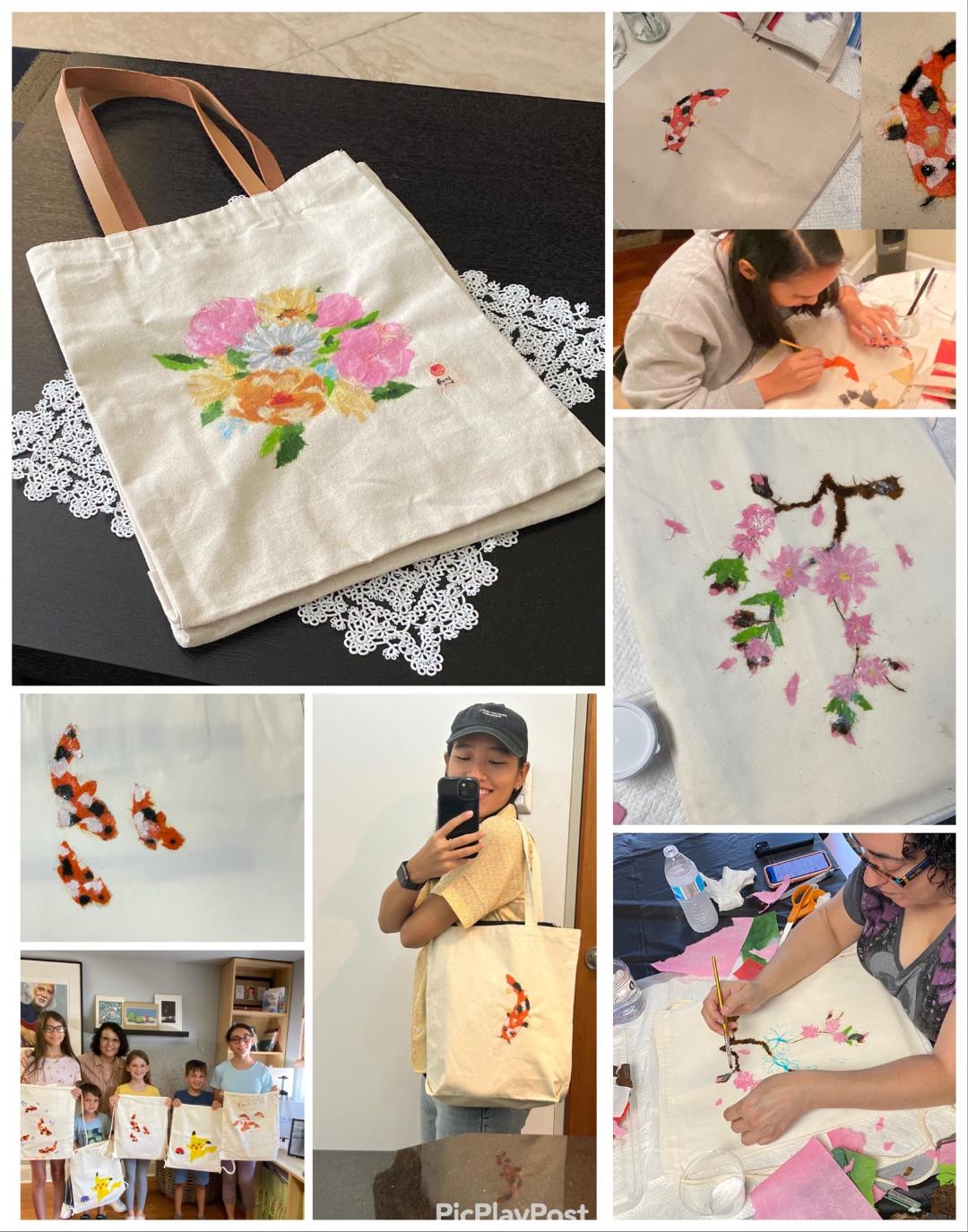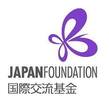|
|
Next Class Date: Sept 30th, 2023. 10am - 12:00pm.
CLASS FULL! REGISTRATION CLOSED. $10 Materials fee is not included in registration price and can be paid directly to the instructor on the day of class. Each student will create one large, decorative canvas tote bag like the ones shown on this page. (Style of bag is dependent upon availability). Please note: This class takes place on the second floor of our facilities and can only be accessed by stairs at this time. Please notify us if you have mobility issues and we can make accommodations. Classes are located at 37114 N thrill Hill Rd Eustis Florida 32736. Look for the dojo sign and follow the driveway to the top. Please park in the grassy area in front of the Block building. Children 16 and under must be accompanied by an adult. |
Chigiri-e (ちぎり絵) is a Japanese art form in which the primary technique uses colored paper that is torn to create images, and may resemble a watercolor painting. The technique dates from the Heian period of Japanese history when it was often used in conjunction with calligraphy. Handmade paper is essential for the creation of chigiri-e images.
In Japan's Heian period chigiri-e was used in conjunction with calligraphy. Poems were written on a background of either plain or decorated colored paper, such as in the textural passages of the Genji scrolls. In the 11th century calligraphy paper was usually white or light blue. It could be decorated and colored and then mounted onto a support.
Chigiri-e has become a popular art form. It can be used to create either realistic images or abstract ones. Its use in Japan is often decorative, using flowers and landscapes as subject matter. The paper may be colored by the craftsman paper-maker but many chigiri-e artists color the paper themselves, using vegetable dyes, colored inks or powder pigments. The paper most often used is Tengujoshi: a handmade, long-fibered, very light weight paper.
The craft of paper-making had almost disappeared until, in the early 1900s, a craftsman developed Tengujoshi, one of the strongest and finest papers currently made. The craft takes three years to learn. This paper, due to its strength, transparency and lightness, is also used for repairing and restoring paintings and other art works. The paper can be made in any range of colors, or may be uncolored. Although very light weight its long fibers assure its strength. It is made with 100% mulberry and is sifted through bamboo boards woven with a layer of silk; only about 100 sheets may be produced in one day. There is also a less-labor-intensive machine-made version of Tengujo paper.
Traditionally Heian calligraphy backgrounds incorporated Chinese patterns and themes and are often used in woodblock techniques to achieve them (grasses, bamboo, water). These themes are still used. Colorful collages could be made with torn (chigiri-e) or cut (kiri-e) paper. Some were further decorated with color pigments or metallic dust. This provides the under-drawing for aristocratic calligraphy. The combination of texture and transparency results in a characteristic richness of color. "Color names and layered colors are woven throughout Heian poetry and literature. The use of layered color is also found in clothing in this period. In many collage techniques found images are used but in chigiri-e the torn paper itself is used to create images.
Temari (手まり) balls are a folk art form and Japanese craft, originating in China and introduced to Japan around the 7th century A.D.[1] "Temari" means "hand ball" in Japanese. Balls made from embroidery may be used in handball games and other such similar games (e.g., hacky sack). An accessory similar in appearance (and constructed with similar techniques and materials), but with the addition of a hand-strap (made with either satin cord or ribbon) and a tassel, can serve as an accessory for a kimono; a kimono bag.
About the Instructor: Ery Yoshida
Yoshida sensei, known as Patty to all her friends, is an artist and art instructor based in the City of Mount Dora where she shares her Japanese inspired art through workshops designed for students interested in learning about Japanese Arts and Crafts.
Born in Peru, where her grand parents migrated from Japan early in the 20th century, Ery showed an interest in drawing and painting from an early age and was particularly inspired by the art of Japan. Encouraged by her parents, she practiced with all kinds of media and as a young child she would eagerly and anxiously await the craft magazines which would arrive from Japan.
After graduating from San Marcos Medical School in Lima, Peru she moved to the United States and in 2001, found herself in Mt Dora where she now lives with her husband. Art came alive again for her when she found the opportunity to cultivate her creativity and passion for all kinds of art under the guidance and tutelage of Fine Artist Lucina Roark. Today, Ery is an active practitioner at Hummingbird Studio, Mount Dora, a place where art and design meet. There, she offers instruction in Chigiri-e, Silk Painting, Cotton Shibori Dyeing, Temari Making, and displays many examples of her work in mixed media, fabric, fibers and resin.
In Japan's Heian period chigiri-e was used in conjunction with calligraphy. Poems were written on a background of either plain or decorated colored paper, such as in the textural passages of the Genji scrolls. In the 11th century calligraphy paper was usually white or light blue. It could be decorated and colored and then mounted onto a support.
Chigiri-e has become a popular art form. It can be used to create either realistic images or abstract ones. Its use in Japan is often decorative, using flowers and landscapes as subject matter. The paper may be colored by the craftsman paper-maker but many chigiri-e artists color the paper themselves, using vegetable dyes, colored inks or powder pigments. The paper most often used is Tengujoshi: a handmade, long-fibered, very light weight paper.
The craft of paper-making had almost disappeared until, in the early 1900s, a craftsman developed Tengujoshi, one of the strongest and finest papers currently made. The craft takes three years to learn. This paper, due to its strength, transparency and lightness, is also used for repairing and restoring paintings and other art works. The paper can be made in any range of colors, or may be uncolored. Although very light weight its long fibers assure its strength. It is made with 100% mulberry and is sifted through bamboo boards woven with a layer of silk; only about 100 sheets may be produced in one day. There is also a less-labor-intensive machine-made version of Tengujo paper.
Traditionally Heian calligraphy backgrounds incorporated Chinese patterns and themes and are often used in woodblock techniques to achieve them (grasses, bamboo, water). These themes are still used. Colorful collages could be made with torn (chigiri-e) or cut (kiri-e) paper. Some were further decorated with color pigments or metallic dust. This provides the under-drawing for aristocratic calligraphy. The combination of texture and transparency results in a characteristic richness of color. "Color names and layered colors are woven throughout Heian poetry and literature. The use of layered color is also found in clothing in this period. In many collage techniques found images are used but in chigiri-e the torn paper itself is used to create images.
Temari (手まり) balls are a folk art form and Japanese craft, originating in China and introduced to Japan around the 7th century A.D.[1] "Temari" means "hand ball" in Japanese. Balls made from embroidery may be used in handball games and other such similar games (e.g., hacky sack). An accessory similar in appearance (and constructed with similar techniques and materials), but with the addition of a hand-strap (made with either satin cord or ribbon) and a tassel, can serve as an accessory for a kimono; a kimono bag.
About the Instructor: Ery Yoshida
Yoshida sensei, known as Patty to all her friends, is an artist and art instructor based in the City of Mount Dora where she shares her Japanese inspired art through workshops designed for students interested in learning about Japanese Arts and Crafts.
Born in Peru, where her grand parents migrated from Japan early in the 20th century, Ery showed an interest in drawing and painting from an early age and was particularly inspired by the art of Japan. Encouraged by her parents, she practiced with all kinds of media and as a young child she would eagerly and anxiously await the craft magazines which would arrive from Japan.
After graduating from San Marcos Medical School in Lima, Peru she moved to the United States and in 2001, found herself in Mt Dora where she now lives with her husband. Art came alive again for her when she found the opportunity to cultivate her creativity and passion for all kinds of art under the guidance and tutelage of Fine Artist Lucina Roark. Today, Ery is an active practitioner at Hummingbird Studio, Mount Dora, a place where art and design meet. There, she offers instruction in Chigiri-e, Silk Painting, Cotton Shibori Dyeing, Temari Making, and displays many examples of her work in mixed media, fabric, fibers and resin.










